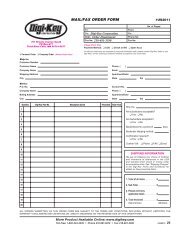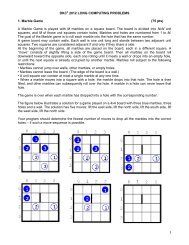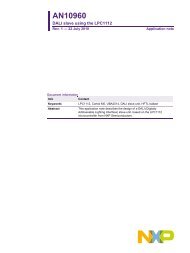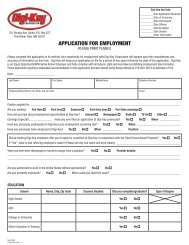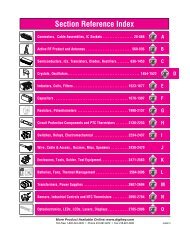Microcontroller Solutions TechZone Magazine, April 2011 - Digikey
Microcontroller Solutions TechZone Magazine, April 2011 - Digikey
Microcontroller Solutions TechZone Magazine, April 2011 - Digikey
You also want an ePaper? Increase the reach of your titles
YUMPU automatically turns print PDFs into web optimized ePapers that Google loves.
Voice synthesizer<br />
The RC Systems V-Stamp voice synthesizer is an easy-to-use, textto-speech<br />
processor. The V-Stamp is a fully self-contained module,<br />
requiring only power, a speaker, a resistor, two capacitors, and a serial<br />
connection to an embedded system. The V-Stamp communicates with<br />
the embedded system using a UART. The module automatically sets<br />
its baud rate to that of the embedded system. From both a hardware<br />
and firmware point of view, there is very little work required to add<br />
the V-Stamp module to the RSS feed reader.<br />
Firmware<br />
Figure 11: HTTP communication protocol.<br />
Figure 10: Firmware block diagram.<br />
HTTP<br />
HTTP is the communication protocol of the World Wide Web. HTTP is<br />
used to transfer web pages (hypertext documents) across the Internet.<br />
An HTTP connection has two parts, the HTTP client (web browser) and<br />
the HTTP server. The HTTP client is used to receive and view the web<br />
pages. The HTTP server is used to store, organize, and transfer the<br />
web pages.<br />
HTTP is defined by RFC 1945 and RFC 2616. RFC 1945 defines<br />
HTTP 1.0, and RFC 2616 defines the latest version, HTTP 1.1.<br />
HTTP is a request-response protocol. The client requests a web<br />
page from the server and the server responds with the web page<br />
contents. HTTP can be used to send any type of data, including<br />
binary data. The client requests a file using the GET method (HTTP<br />
is an ASCII protocol). The server responds with an HTTP header<br />
followed by the file contents. Within the request, the version number<br />
of the HTTP is also embedded in ASCII. This tells the server the<br />
limitations of the client.<br />
Really Simple Syndication (RSS)<br />
RSS feeds are available everywhere on the Internet. The idea behind<br />
the RSS feed is to convey dynamic textual information in a simple<br />
standard format.<br />
RSS originated in 1999 with the idea of providing content in a<br />
simple easy-to-understand format. Instead of describing a complete<br />
document in the way that HTML does, RSS feeds use XML to describe<br />
data. An RSS feed is simply an XML document containing data. The<br />
methods used to convey the data within the XML document are<br />
described in the RSS 2.0 specification. All RSS files must conform<br />
to the XML 1.0 specification. RSS feeds generally use HTTP as the<br />
transport mechanism.<br />
Extensible Markup Language (XML)<br />
The XML 1.0 specification can be found at www.w3.org/TR/REC-xml/.<br />
XML is a language used to describe and parse information. It is very<br />
similar to structures in C.<br />
Data is organized into elements, with each element assigned to a<br />
tag. The data in the element is surrounded by a start tag and an<br />
end tag. The name in the start and end tags defines the element’s<br />
type. The end tag name must be the same as the start tag name,<br />
except the end tag is identified by the addition of a “/” before the<br />
tag name.<br />
Tags<br />
Here is an example of an XML tag:<br />
Advanced ColdFire TCP/IP Clients<br />
TITLE is the type, is the start tag, and is the end<br />
tag. The data is between the tags. Just like a C data structure, the<br />
data is associated with the type. The data between the start and end<br />
tags is referred to as the element’s content.<br />
www.digikey.ca/microcontroller<br />
31



